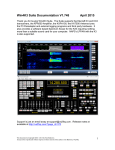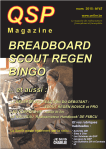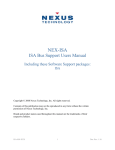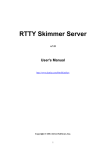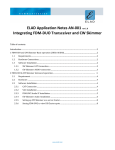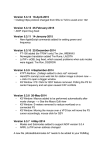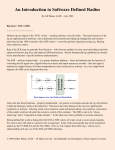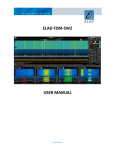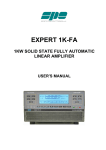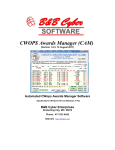Download Pileup Runner
Transcript
Pileup Runner
v.1.4
User's Manual
http://www.dxatlas.com/PileupRunner
Copyright (c) 2012 Afreet Software, Inc.
TABLE OF CONTENTS
QUICK START...................................................................................................................3
PILEUP SETTINGS.......................................................................................................... 3
NAVIGATION..................................................................................................................... 4
SENDING MESSAGES...................................................................................................... 5
LOGGING........................................................................................................................... 6
DATA FOLDERS.................................................................................................................7
DXERS' CALLSIGNS.........................................................................................................7
DSP CHAIN.........................................................................................................................7
PILEUP BEHAVIOUR........................................................................................................ 7
TIPS AND TRICKS............................................................................................................. 8
VERSION HISTORY.......................................................................................................10
QUICK START
1. Start the program.
2. If you have more than one audio device in your system, click on Settings / System in
the menu and select the device to use in the Output Audio Device drop-down list. Click
on OK. It is recommended that you use your headphones instead of the speakers, this
makes copying CW much easier. My own machine has two soundcards, one feeds the
speakers for Windows sounds, music, etc., the other one feeds the headphones and is used
by all of my Ham applications.
3. Press F9 to start the audio. While the audio is running, click on Settings / Radio in the
menu, and adjust Audio Gain and CW Pitch
Pitch. Now press F1 to start transmission, and
adjust the Sidetone Gain and Keyer Speed settings. Click on Run / Stop Pileup in the
menu to stop the audio. You can keep the Radio Settings dialog open if you want, and
change the settings on the fly while working the pileup.
4. You are ready to work the pileup. Click on Run / Start Pileup
Pileup, click on OK to accept
the default parameters of the pileup, and the DX'ers will start calling you right away.
Copy and type in a callsign and press the ";" key on the keyboard to send the call and
599
". Once the DX'er answers, press "." to send "TU UP
" and write the QSO to the
"599
599"
UP"
log.
PILEUP SETTINGS
The Pileup Settings dialog that opens when you start a pileup allows you to set the
parameters of the pileup.
DX-pedition Callsign:
Enter any callsign you want there.
Operator's Callsign:
Be sure to enter your own home callsign in this field.
Number of Callers:
Enter a value between 1 and 1000. You can either select one of the pre-defined values
from the drop-down list, or type a custom value in. One of the advantages of a
simulated pileup is that all of its characteristics, such as the number of calling stations
and signal strength of each station, are always known. Using this software, you will
quickly learn how to determine the actual number of callers in the pileup just by
looking at the waterfall display.
Average SNR, dB:
This is a parameter that you can change to simulate different propagation conditions.
The values between 3 dB and 30 dB are accepted. 30 dB sounds like 10m in 1978,
while 3 dB sounds more like 160m in 2012. The SNR is computed the same way as in
CW Skimmer.
Difficult Continent:
Select either AS, EU, or NA as difficult continent (SA, AF and OC always count as
difficult). The signals from the difficult continents are weaker than from the easy ones,
but a QSO with such continent adds 3 points to your score, while a normal QSO gives
you only 1 point.
Session Length:
Enter the length of your session, in minutes. The pileup will stop automatically after
the time entered in this field. Of course, you can click on Pileup / Stop to terminate the
session at any time and get your score.
Record I/Q WAV file:
If this check-box is ticked, the program records your session in the I/Q format that can
be played back in CW Skimmer and many other SDR programs. 48 kHz of spectrum
are recorded.
Practice/Competition:
Only the Practice mode is currently implemented.
NAVIGATION
Pileup Runner has the same waterfall display as CW Skimmer, and its navigation
commands are a subset of the Skimmer commands. Use the PageUp and PageDown keys
to scroll the display one page up or down. Click on the waterfall display or on the
frequency scale to tune the receiver to the frequency under the mouse cursor. The button
with arrows near the frequency display, when clicked with the left and right mouse
buttons, performs the PageUp and PageDown commands respectively.
The green rectangle on the frequency scale represents the passband of your receiver with
the light green triangle marking the center frequency. Drag the passband rectangle with
the mouse vertically, or use the Up and Down arrow keys to change the bandwidth of
your filter.
The red triangle marks your transmit frequency, the pileup starts 1 kHz above it.
Unlike CW Skimmer, Pileup Runner has a second, slow waterfall display. The mouse
clicks on that display work the same way as on the main display. You can change the
width of the slow display, or hide it completely, by dragging the splitter between the
display and frequency scale.
Drag the frequency scale vertically with your mouse to see the signals above and below
the current screen.
Drag the waterfall display to the right with your mouse to see the signals that have
already scrolled away. This puts the pileup in the pause state, as if you clicked on Run /
Pause Pileup in the menu. Click on Pause Pileup to resume the session.
SENDING MESSAGES
The messages can be sent either by clicking on the buttons under the callsign input box,
or by pressing the F keys. The following messages are supported:
F1
F2
F3
F4
F5
F6
F7
=
=
=
=
=
=
=
"QRZ DE <my_call> UP
"
UP"
"
"599
599"
"
"TU UP
UP"
<my_call>
<his_call>
"
"NIL
NIL"
"
"AGN
AGN"
The mapping between the F keys and the messages can be changed in the Settings
dialog
dialog.
The following macro shortcuts are easier to use than the F keys, especially for those who
type with ten fingers:
"\"
";"
"." <Insert>
=
=
=
"
"QRZ DE <my_call> UP
UP"
"
"<his_call> + 599
599"
" + <Write to log>
"TU UP
UP"
You can assign different keys to the ";" and "." macros in the Settings dialog, either by
entering the key codes in the Macros / Key Code input boxes, or by clicking on the
"Z"
buttons with ellipses and then pressing the desired keys. Do not assign the "A"
"A".."Z"
"Z",
"9" and "/" keys to the macros, you will need those keys to enter the callsigns.
"0"
"0".."9"
" message every N-th QSO,
The DX callsign is automatically included in the "TU UP
UP"
". The value of N may be set between 1 and 10 in the
turning it into "TU <my_call> UP
UP"
Settings Dialog
Dialog.
To abort transmission, press the Escape button.
To clear the callsign input box, press Ctrl-W
Ctrl-W, Alt-W or F11
F11.
To write the QSO to the log, press Enter
Enter, or click on the Save button.
If the callsign in the callsign input box has changed after it was sent last time, then the
"." macro key automatically re-sends the callsign before finishing the QSO.
HINT: To answer a call quickly, you can type in the callsign prefix and press the ";" key.
While the program is sending the prefix, type in the rest of the callsign.
The ESM (Enter Sends Message) mode allows the operator to perform different tasks at
Enter
different stages of the QSO by pressing the same key (Enter
Enter). This mode can be turned
on and off in the Settings dialog using the ESM check-box. At the initial stage, when
the callsign input box is empty, the Enter key sends the QRZ message. Once the callsign
". After you copy the "exchange" and
is entered, the same key sends "<his_call> + 599
599"
" and writes the QSO to the log. The message
press the Space key, Enter sends "TU UP
UP"
buttons corresponding to the current function of the Enter key have red labels.
LOGGING
The log panel shows the last 5 QSO, including the time, callsign, frequency, continent,
SNR and a QSO status symbol. The following status symbols are used:
+
*
space
Valid QSO, 1 point
Valid QSO, 3 points
Incorrect callsign (0 points). The correct one is shown in the braces.
The QSO is not in the correspondent's log: either he is still copying your
message, or he is waiting for your final TU, or the call you have entered is
completely wrong and there is no such station in the pileup.
The full session log is saved in the ADIF format at the end of the session, so you can use
your favourite log analysis tools to generate statistics, or perhaps do some research.
The results of every session are added to the History file, a plain text file that can be
opened using the File / History command.
COMPETITION MODE
Select the Competition radio button in the Pileup Settings dialog to switch from the
Practice mode to the Competition mode. The score that you achieve in this mode may be
submitted the High Scores table on the Pileup Runner web site. The following pileup
parameters are fixed in the competition mode:
Number of callers
Average SNR
Session Length
100
15 dB
15 min.
The color of the log panel changes from blue to red in the competition mode.
To submit your competition results to the online table, open the History file, copy the line
with your score to the Clipboard, then paste it in the input box on the web page. Be sure
to copy the whole line, including the signature at the end. Note that any changes to the
line invalidate the signature.
Only the lines with Competition in the Mode field may be submitted to the online table,
the lines with Practice are only for your own information.
DATA FOLDERS
Since Windows no longer allows the programs to write to their own folder, Pileup Runner
stores its data in a special data folder designated by operating system. The location of this
folder is different on every machine. Use the menu commands under File to open the
folders containing the I/Q WAV recordings and ADIF logs, and to access the History file.
DXERS' CALLSIGNS
The list of DXers' callsigns has been produced by Michael G7VJR from his ClubLog data
(MNI TNX!). These are real callsigns of the real DX'ers who worked a certain minimum
number of DX-peditions in the last few years. Be prepared to hear many familiar calls in
the pileup! You can even work yourself if you are lucky enough.
DSP CHAIN
When the program generates the audio for you and plots the waterfall display, it does not
cheat, and does not cut corners. After the I/Q stream containing all signals is generated,
it is processed by the code identical to that in CW Skimmer, as if it were received from a
radio. The processing includes filtering, AGC, FFT, key click canceling, etc. This ensures
that the quality of the audio and waterfall graphics are the same in a simulation and on the
air.
PILEUP BEHAVIOUR
The pileup simulator tries to model many features of the real pileups. I the simulation, the
DX'ers copy your signals most of the time, but sometimes they cannot copy their own call,
or accept an incorrectly sent call, or miss your transmission completely. You will notice
that they use all kinds of variations on the "599 TU" theme, from plain "599" to
something like "BK DE XX0XXX TU 599 599 GL 73 DE XX0XXX TU E E"
E". Be
patient and do not send your final TU until your correspondent finishes sending his
message, or you may end up being not in his log.
The DX'ers do their best to work you, but their skill levels are different. Some of them
just keep calling blindly on the same frequency in a hope that you will eventually tune
across their signals, some at least monitor their own TX frequency and QSY when
necessary to ensure that their signal is more or less in the clear, but there are also
experienced DX'ers who try to figure out your listening frequency, and they often succeed
" to you, some of the experienced
in this. As soon as your correspondent sends "599
599"
DX'ers know where you are listening, and tune to, or near, that frequency. Do not listen
on the same frequency for too long, unless you want to see half of the pileup squeezed in
the passband of your receiver.
TIPS AND TRICKS
Since Pileup Runner has the same waterfall display as CW Skimmer, you can use all
tricks that you would use if you were running a pileup with the Skimmer. Here are a few
for you to try.
The QSO with the difficult continents are more valuable than with the easy ones, which is
also true for a real DX operation. Since you get 3 points for a difficult continent, you can
spend up to 3 times more time on such QSO and still have a better score. Find a 3-point
" to you, then
station on the waterfall visually while your correspondent is sending "599
599"
". Look for the weak signals
click-to-tune to that station while you are sending "TU UP
UP"
on the waterfall as these are often 3-point stations.
Learn to read Morse Code visually off the waterfall display. With some practice, you will
be able to visually copy all signals that you can copy aurally, including the high-speed
and very weak stations. This skill has multiple uses, from finding the 3-point stations to
verifying the calls you copy by the ear, to making a QSO with a station that is not even in
your passband. Indeed, you can copy the callsign visually and answer her call, then copy
", again visually, and save the QSO to the log, all without hearing the station. If
her "599
599"
you use this technique to work a station a few kHz away from where you are listening,
those who are chasing your QSX frequency will move there (well, at least some of them),
allowing you to work a few more stations in the clear.
Do not neglect the PageUp command. The pileups are often much thinner near the top
than at the bottom, be sure to page through the whole pileup and always work in the areas
with a low concentration of the callers.
As has already been said, staying on the same listening frequency for more than a few
QSO is a sure way to cause problems to both your callers and yourself. Even if you did
not have time to find a good new frequency in advance, just tune 2-3 kHz up or down,
this requires only a single mouse click on the waterfall. The slow waterfall available in
Pileup Runner may give you a rough idea of where in the pileup the density of the
stations is low.
VERSION HISTORY
10
20122012-10
10--10 1.
1.44
�
�
�
Increased space between the callsigns when the calling station sends its call twice
The "." macro key, if pressed twice, does not add a duplicate QSO to the log
If the operator changes the listening frequency by more than 300 Hz, the callsign
input box is automatically cleared
05 1.
20122012-1100-05
1.33
�
�
�
�
�
Competition mode added
";" and "."
Macro (";"
".") keys re-assignable by user
Arrow up and down keys control filter bandwidth
Improved artificial intelligence behind the calling stations
Auto-send DX callsign every N-th QSO
2012-09-2
2012-09-288 1.
1.22 Beta
�
Improved performance on slow computers
2012-09-26 1.1 Beta
�
�
F key mapping
ESM mode
2012-09-24 1.0 Beta
�
Initial release











